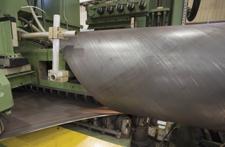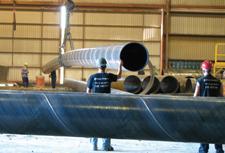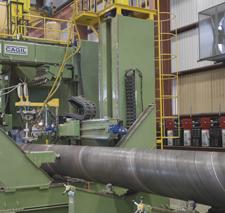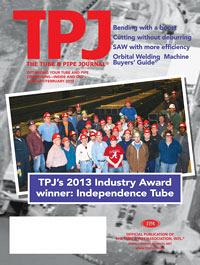- FMA
- The Fabricator
- FABTECH
- Canadian Metalworking
Categories
- Additive Manufacturing
- Aluminum Welding
- Arc Welding
- Assembly and Joining
- Automation and Robotics
- Bending and Forming
- Consumables
- Cutting and Weld Prep
- Electric Vehicles
- En Español
- Finishing
- Hydroforming
- Laser Cutting
- Laser Welding
- Machining
- Manufacturing Software
- Materials Handling
- Metals/Materials
- Oxyfuel Cutting
- Plasma Cutting
- Power Tools
- Punching and Other Holemaking
- Roll Forming
- Safety
- Sawing
- Shearing
- Shop Management
- Testing and Measuring
- Tube and Pipe Fabrication
- Tube and Pipe Production
- Waterjet Cutting
Industry Directory
Webcasts
Podcasts
FAB 40
Advertise
Subscribe
Account Login
Search
Tube, pipe producer executes 3-phase improvement plan
Trinity plan focuses on line workers, equipment, management
- January 18, 2013
- Article
- Tube and Pipe Production
Since it was founded as a pipe distributor in 1979, Trinity Products, O’Fallon, Mo., has been expanding its horizons.
It added fabrication services in 1986 and began pipe production in 2007. Trinity’s product portfolio includes 24- to 127-in. pipe up to 1-in. wall thickness. It serves customers in construction and related industries—piling contractors, road-boring contractors, utility contractors, and customers in the caisson industry—providing products for everything from billboards to building structures.
However, it knew that its product quality and customer diversity weren’t necessarily enough to be successful in this competitive industry.
Management knew that it would have to take steps to make its proucts stand out from the competition’s as the economy slowly recovered from the financial collapse of 2008.
“In such a challenging economic climate, business as usual wouldn’t ensure survival of this family-oriented company,” said Robert Griggs, president of Trinity Products.
So in 2011 Trinity’s management embarked on a three-phase quality improvement plan to help the company achieve success and growth, despite the rough economy.
All Eyes Focused on Weld Quality
Trinity’s business culture is based on open-book management, inspired by Jack Stack and Bo Burlingham’s work The Great Game of Business, which encourages employees to be actively involved in issues that affect their jobs. It has also helped the company execute its three-phase plan.
As part of this business philosophy, company management shares financial information with all employees at regular monthly meetings and actively seeks input and suggestions on current issues from its workforce. The company’s incentive program rewards all employees equally with an annual bonus if the company meets various goals for sales, productivity, safety, and quality.
Phase One of the plan focused on improving productivity and the weld quality of Trinity’s products. Management began by tracking the amount of time that production was shut down for operational reasons, maintenance, and mechanical breakdowns, and then analyzed this information to identify and address recurring issues. It wasn’t long before they realized that simply improving mechanical maintenance would allow them to run the mills faster and for longer periods, increasing throughput.
Next, management set new fabrication standards and tolerances, with emphasis on training, tracking, inspecting, and logging. They also created pictures of reference welds and repairs and developed a system for regular employee training, including new weld training manuals.

Edge preparation and presentation are just as critical in spiral welding for pipe as they are for any other welding process. As part of its quality improvement plan, Trinity installed laser-based measuring devices that help to eliminate human error.
To continue to improve the mill’s output, Trinity turned its attention to the input, tracking the raw material quality and vendor performance. The company then provided feedback to the vendors to find ways to manufacture materials that better fit Trinity’s needs. In doing this, management discovered that each vendor had its own individual product strengths, so they developed plans to evaluate vendors on a continual basis to align the materials they procure with the specific products they make.
Additionally, the company recorded and benchmarked such factors as mill speeds, welding current and voltage, and macroedge quality.
Finally, the company offered classes to its employees focusing on fabricating techniques and the technical aspects of making pipe. These courses were designed to expand employees’ knowledge and skill sets, thereby improving weld quality and ultimately increasing mill speeds. The classes also addressed new areas for the workers: inspection and handling.
Phase One is testimony to the company’s overarching management philosophy.
“Every employee has an equal voice,” said Jim Nazzoli, COO. “It doesn’t matter who you are … everybody’s job is as important as everybody else’s.
Ramping up Productivity
After the quality was improved, the Phase Two focus turned to productivity improvements.
“You have to start with quality product. Once you have quality dialed in, then you can ramp up production speed,” said Nazzoli.
To improve the mill’s productivity, the management team started by focusing on the welding power supply, looking for a good fit for its three-phase plan. It looked for a machine that would provide a variety of settings for the various products it makes, as well as provide monitoring capabilities. It chose Power Wave® AC/DC 1000® machines from The Lincoln Electric Co. The power supplies have software that allows Trinity’s shop floor to monitor their machines live and use the vendor’s website as a resource for troubleshooting. Employees can even take an electronic snapshot of any issue and send it to the supplier for diagnosis.
Trinity also installed new equipment and controls from Uhrhan-Schwill, which specializes in welding systems for large-diameter pipe. This new equipment provided the company with a stable welding head system that positions the welding electrodes where they need to be and holds them there.
Spotlight on Management Skills

Because the welding electrodes in submerged arc welding (SAW) are covered by flux, a vision system cannot determine if they are positioned properly. Trinity’s new welding system allows employees to dial in the optimal position and keeps the electrodes in place.
After addressing weld quality and mill productivity, Trinity began to focus on the plan’s third phase: management skills. The company now offers regular management classes to its employees, including sessions on leadership, communications, and quality control. The company says it is dedicated to fostering key skills the staff needs to grow into the role of future company leaders.
“We place a high value on hiring the right people and providing an opportunity to make a lasting and meaningful career,” said Griggs. “This involves placing them in the right position for their skill sets and nurturing them with ongoing training and development.”
Trinity now also offers an annual continuing education course (pipe school), whereby customers’ professional engineers can receive 13 continuing education credits while receiving instruction on how steel pipe is made, how to identify high-quality products, and insights into the latest products and technologies. The classes aren’t led just by Trinity management; other pipe vendors are invited to make presentations. Thinking beyond their own bottom line, the company’s goal is to educate its customers about the importance of pipe mills and what they can offer.
Tallying It Up
The plan has led to several positive results, including new production records.
“We’re seeing nearly 100 percent improvement over where we were two years ago,” Nazzoli said. “We used to celebrate producing 2,000 tons a month. Now we expect to produce almost 4,000 tons a month.”
Improvements show up other areas, too, such as its flux consumption. Measured by determining the wire-to-flux ratio, this number has improved from 3-to-1 to a range of 1.3- to 2.1-to-1. This improvement, gained by partnering with Lincoln Electric to improve the flux delivery and recovery processes, might not seem substantial, but in fact it is; the result is a savings between $50,000 and $100,000 per year.
“We’re doing quite well in these tough times,” said Nazzoli. ”When the economy turns around, we’ll be in a good position. We’ve worked hard in these lean times to position
ourselves.”About the Publication
Related Companies
subscribe now

The Tube and Pipe Journal became the first magazine dedicated to serving the metal tube and pipe industry in 1990. Today, it remains the only North American publication devoted to this industry, and it has become the most trusted source of information for tube and pipe professionals.
start your free subscription- Stay connected from anywhere

Easily access valuable industry resources now with full access to the digital edition of The Fabricator.

Easily access valuable industry resources now with full access to the digital edition of The Welder.

Easily access valuable industry resources now with full access to the digital edition of The Tube and Pipe Journal.
- Podcasting
- Podcast:
- The Fabricator Podcast
- Published:
- 04/16/2024
- Running Time:
- 63:29
In this episode of The Fabricator Podcast, Caleb Chamberlain, co-founder and CEO of OSH Cut, discusses his company’s...
- Trending Articles
Team Industries names director of advanced technology and manufacturing

Orbital tube welding webinar to be held April 23

Chain hoist offers 60-ft. remote control range

Push-feeding saw station cuts nonferrous metals

Corrosion-inhibiting coating can be peeled off after use

- Industry Events
16th Annual Safety Conference
- April 30 - May 1, 2024
- Elgin,
Pipe and Tube Conference
- May 21 - 22, 2024
- Omaha, NE
World-Class Roll Forming Workshop
- June 5 - 6, 2024
- Louisville, KY
Advanced Laser Application Workshop
- June 25 - 27, 2024
- Novi, MI




























